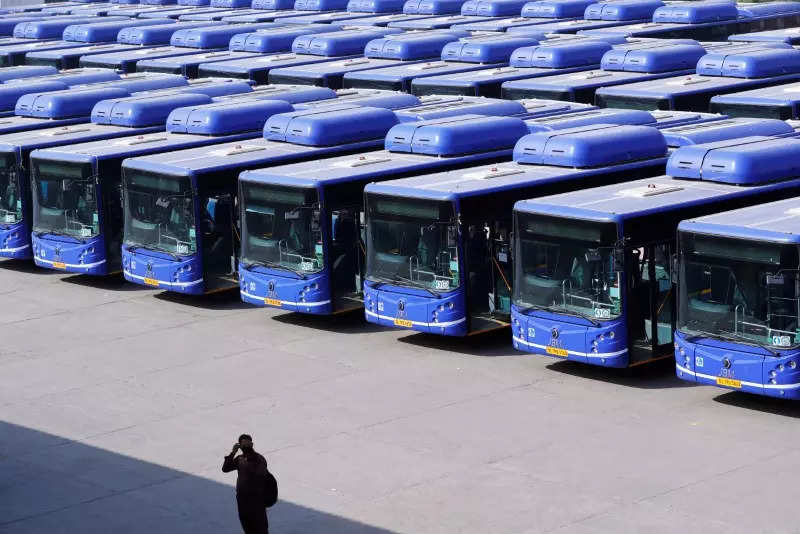
In 2017, India’s first electric bus was deployed in the hill town of Manali. After this pilot project was launched in Himachal Pradesh with a fleet of 25 buses—none of them was air conditioned and each had a standard length of 9 metres—the country has added close to 5,000 e-buses of various configurations across cities.
With the government subsidising these environment-friendly but expensive vehicles, India Inc swung into action, building shop floors to augment capacities for making this new breed of buses.
This journey took off in 2015 when the government announced a scheme called Faster Adoption and Manufacturing of Electric Vehicles (FAME). Now, at least half a dozen EV makers in India, with plants in Faridabad, Dharwad, Lucknow, Ennore, Pune and Hyderabad, have built an annual capacity of more than 40,000 ebuses, engendering industry-readiness for future orders from government and private operators.
Last week, the central government decided to give a growth driver to ebuses. It said it would partly finance 10,000 electric buses across cities, which augurs well for commuters, environment as well as the country’s fledgling electric vehicle (EV) industry. With this policy intervention, India’s e-bus segment is expected to grow eight-ten times in the next five years, according to industry insiders and experts. However, a sustainable financial model is needed to mainstream e-buses, which are just 0.27% of the 1.8 million buses plying across India now.
ELECTRIC PATHWAY
“This scheme communicates a clear signal to the auto industry that India intends to go towards electric vehicles, giving them a nudge to plan accordingly,” says OP Agarwal, former global transport advisor in the World Bank, adding that the public-private partnership (PPP) mode of the scheme may improve operational efficiency.
Last year, the government announced its ambitious plan to deploy 50,000 e-buses between 2022 and 2027 under the National Electric Bus Programme (NEBP)—a target, if implemented, will result in a widespread presence of e-buses on Indian roads.
Even though the government’s intent to roll out e-buses is clear, there could be bottlenecks in the form of high capital cost. For example, a 9-mlong e-bus costs INR 90 lakh to INR 1 crore, which is two-three times costlier than its diesel counterpart. A viable source of funding is, therefore, essential for the successful ride of e-bus business in India.
Now, FAME II is following a unique financing model called Gross Cost Contract (GCC) under which a private party invests in the purchase of both the bus and the charging infrastructure and takes up the responsibility of operations and maintenance over a 12-year contract period. The private player, in turn, is paid a fee per kilometre, which is discovered through bidding.
“There are specific eligibility criteria for securing FAME II incentives,” says Mahesh Babu, CEO of Switch Mobility, the EV arm of India’s multinational automotive manufacturer Ashok Leyland. About the scheme to procure 10,000 buses, Babu expects the government to either bring in some components of the GCC model or go for viability gap funding (VGF). VGF is a common tool used in PPP projects under which the Centre contributes a share of the project cost as subsidy.
The PM E-bus Seva Scheme, as it is called, will roll out 10,000 buses in 169 cities, mostly in urban areas with no city bus services. This is esti- mated to cost INR 57,613 crore, of which the Centre will provide INR 20,000 crore, according to a gover nment statement issued after the Union cabinet approved the scheme on August 16. The scheme, which will support bus operations for 10 years, will cover cities with a population of 300,000 and above (2011 Census) as well as all capital cities of Union territories, northeastern and other hill states. The programme will have one more component— envision multiple green initiatives such as multimodal inter change facilities, automated fare collection systems and charging infrastructure in 181 cities.
The exact contours of the scheme have not yet been announced, prompting industry leaders to come out with various hypotheses. “Most of the cities selected may develop their individual strategies for execution,” says Nishant Arya, vice-chairman and managing director of JBM Auto, which is setting up an integrated electric bus facility in Haryana with a capacity to manufacture 20,000 buses a year. Arya says six to nine months will be required for the scheme to get going. “The delivery of buses will start only after that,” he adds.
Mahua Acharya, former CEO of Convergence Energy Services Limited (CESL), a government arm under the ministry of power, says EV should not be a big city-phenomenon and this new scheme addresses that by focusing on small cities.
The financial aspects of the scheme are not clear. For instance, how will funds be allocated for procurement, maintenance and subsidies? The financial modality should ensure that the initiative remains sustainable in the long run, with no undue burden on public resources, says Sudhir Mehta, chairman of EKA Mobility and Pinnacle Industries, an EV player.
“To ensure long-term viability of this initiative, it is imperative to establish a clear framework where local bus operators play a major role in the operation of electric buses. They have both expertise and existing infrastructure for a seamless integration of new vehicles into the existing system,” he adds.
Aanchal Jain, CEO of e-bus maker PMI Electro Mobility, is hopeful that the criteria of cities chosen for the scheme— with a population of more than 300,000 and having no organised public transport system—will ensure that e-buses will travel to India’s tier-2 and -3 cities.
In FY 2022-23, when 1,919 e-buses were sold in the country, Jain’s PMI Electro Mobility clinched the largest market share (31.5%) followed by Olectra Greentech (23.1%), Switch Mobility/Ashok Leyland (19.8%), JBM Auto (11.8%) and Tata Motors (6.9%), with the rest being split among smaller entities, according to data collated by JMK Research and Analytics.
As far as order books are concerned, JBM Auto currently leads with 5,000 electric bus orders both from state transport undertakings and private entities. Tata Motors’ order book stands at 2,600 e-buses; it has delivered over 900.
PMI, which has delivered 1,200 e-buses across the country, is sitting on an order book of about 2,500 e-buses. Switch has over 1,000 orders in hand and EKA Mobility & Pinnacle has about 500.
TWISTS & TURNS
There is no doubt that the ebus industry would not have travelled this far had there been no experimentation on financial models. When 10 cities procured the first lot of 425 e-buses under the FAME I scheme between 2017 and 2019, it was mostly a direct purchase method. But between 2019 and 2021, FAME II, with a budgetary support of INR 10,000 crore, adopted the GCC model under which private service providers also shared some risks. However, some cities did not opt for e-buses even though they were eligible for the Centre’s subsidies, forcing NITI Aayog to step in and restructure the scheme for nine big cities. According to an official in the know, less than 5% of the subsidy was utilised till 2021, and out of nine eligible cities, Mumbai, Chennai, Pune and Ahmedabad opted out.
A report released last year by CESL says that “lack of technical capacity to manage the procurement process, reluctance to move towards GCC-based procurement and lack of adequate power infrastructure to charge buses in smaller cities” are some of the reasons why a number of cities such as Visakhapatnam, Nashik and Jaipur did not show much interest initially.
Former urban development secretary M Ramachandran says it’s only natural that some private operators will be reluctant to run e-buses in small cities as “such operations in non-metros are not very profitable”, emphasising the need for a robust and sustainable source of revenue to make the government’s e-bus programme successful beyond the metros.
For the government, however, the rolling out of e-buses is not just about providing a better mode of transportation. It is also about chasing the goal to turn the country net zero by 2070. While subsidising the FAME II scheme, the government claimed that “these e-buses (initially 5,595 buses in 64 cities) would run about 4 million km during the contract period, saving about 1.2 billion litres of fuel and off-setting 2.6 million tonnes of CO2 emissions,” according to a 2020 paper released by international organisation of public transport, UITP (Union Internationale des Transports Publics).
Transport expert Agarwal argues that India should monitor the share of vehicle miles transitioned to electric instead of the share of the total vehicle fleet transitioned. “In particular, personal cars, which are not used for long distances each day and are parked for over 95% of the time, need not be our priority, and spending public funds to support them is not the best use of these limited funds,” he says, adding that the transition of buses, taxis and autorickshaws to the electric mode should get a head start.















